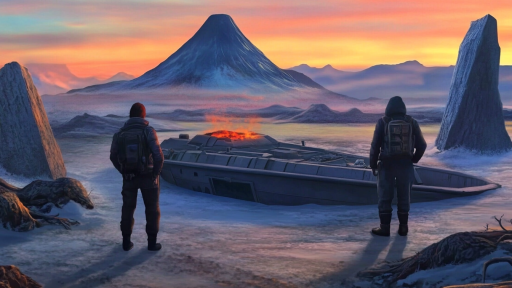
Ancient maps are windows into the minds of explorers, cartographers, and empires long gone. But among the coastlines and kingdoms we recognize, strange shapes, phantom lands, and impossible details often appear—some never explained. These bizarre inclusions challenge everything we know about the past, suggesting either wild imagination… or knowledge lost to time. Could these cartographic curiosities point to forgotten civilizations, forbidden truths, or something stranger?
Hy-Brasil: The Phantom Island of the Atlantic

For centuries, maps depicted an island west of Ireland known as Hy-Brasil. It was believed to appear only once every seven years before vanishing again into mist. Despite numerous expeditions, no trace of the island has ever been found. Some believe it was a myth—others claim it was real, and simply no longer exists.
The Antarctic Coastline Before Discovery

The Piri Reis Map, drawn in 1513, bizarrely shows the coastline of Antarctica—centuries before the continent was officially discovered. Even stranger, it depicts the landmass free of ice, raising questions about ancient knowledge of Earth’s geography. How could a map from the Age of Exploration include details only visible through modern satellite imaging? The implications are staggering.
The Inverted Africa and Asia on the Kangnido Map

Created in Korea in 1402, the Kangnido Map shows an oddly distorted view of the world—but includes detailed renderings of Africa and Europe long before contact was common. Some scholars say it borrowed from Islamic maps, but others argue it contains geographical knowledge that shouldn’t have been possible in East Asia at the time. Its presence challenges traditional narratives of global exploration.
California as an Island

One of the most persistent cartographic mistakes, California was repeatedly shown as a massive island off the west coast of North America for over a century. Despite explorers proving it was part of the mainland, the island-version persisted in countless maps. Was it a simple error… or based on earlier, now-lost accounts of a separated landmass?
The Sea Monsters of Olaus Magnus

The 1539 Carta Marina by Olaus Magnus doesn’t just map Scandinavia—it swarms its seas with giant serpents, krakens, and unexplainable beasts. While many believe these were symbolic warnings or sailor myths, others think they could reference now-extinct or undiscovered creatures. Either way, they add a surreal layer of mystery to ancient navigation.
Mountains of the Moon in Central Africa

Many ancient maps show a dramatic mountain range in central Africa labeled as the “Mountains of the Moon,” supposedly the source of the Nile. Despite centuries of exploration, no such range matching the description has been found. Were the cartographers misled, or did they once exist and vanish through time?
The “Dragon’s Tail” on Early Asian Maps

Some medieval Asian maps feature a strange peninsula stretching into the ocean, labeled as the “Dragon’s Tail.” It doesn’t correspond to any known landmass today and vanishes from later maps without explanation. Was it an exaggerated depiction of Southeast Asia, or a now-submerged land forgotten by history?
The Island of Antillia

Before Columbus sailed west, maps showed a large island called Antillia in the middle of the Atlantic Ocean. It was often linked to legends of exiled Christian monks escaping Muslim conquest. No trace of Antillia has ever been discovered, yet its repeated appearance suggests it was based on more than just folklore.
Greenland’s Impossible Interior

Ancient maps often depict Greenland not as the ice-covered mass we know today, but as a land of rivers, forests, and mountains. These details suggest either wild speculation or an ancient glimpse of the land before it froze over. Could ancient peoples have seen Greenland in a completely different state?
Japan’s Gigantic Size on Early European Maps

In some early European maps, Japan appears massive—sometimes rivaling China or even India in size. This exaggeration likely came from secondhand accounts, but the repeated scale distortion hints at a mysterious importance placed on the island. Was it simply a mapping error, or did it hold more significance than we understand?
The Sahara as a Fertile Land

Certain ancient maps depict the Sahara not as a desert, but as a lush region filled with rivers and cities. While most dismiss this as fanciful artwork, recent satellite scans have revealed buried riverbeds and signs of ancient settlements. Could these maps be remnants of a time when the Sahara was truly green?
The “Unknown Southern Land” That Covered Half the Globe

Many ancient maps show a massive continent called Terra Australis Incognita stretching across the bottom of the world. Cartographers believed a landmass that large had to exist to “balance” the globe. Though modern Antarctica is real, it’s far smaller—so where did this colossal southern continent come from in the minds of early mapmakers?
Maps Showing the Amazon with Cities

Several ancient maps depict the Amazon basin filled with named cities and complex road systems. While dismissed for years, recent archaeological discoveries suggest large civilizations may have thrived there before the jungle reclaimed them. Were these maps based on real sightings that history later forgot?
Secrets Written in the Lines

Ancient maps do more than guide—they reveal the mindset, fears, and mysteries of past civilizations. Many of their oddities have yet to be fully explained, blurring the line between myth and history. Whether they point to forgotten lands, vanished cultures, or ancient knowledge lost to time, these anomalies remind us that even our past remains uncharted. Perhaps we’ve only just begun to rediscover what the ancients once knew.





